Digestion of Food | Biology for JAMB PDF Download
| Table of contents |

|
| Physiology of Digestion |

|
| Chemical Digestion |

|
| The Small Intestine |

|
| Functions of Small Intestine |

|
Physiology of Digestion
- Digestion is the process of mechanically and enzymatically breaking down food into substances for absorption into the bloodstream.
- The food contains three macronutrients that require digestion before they can be absorbed: fats, carbohydrates, and proteins. Through the process of digestion, these macronutrients are broken down into molecules that can traverse the intestinal epithelium and enter the bloodstream for use in the body.
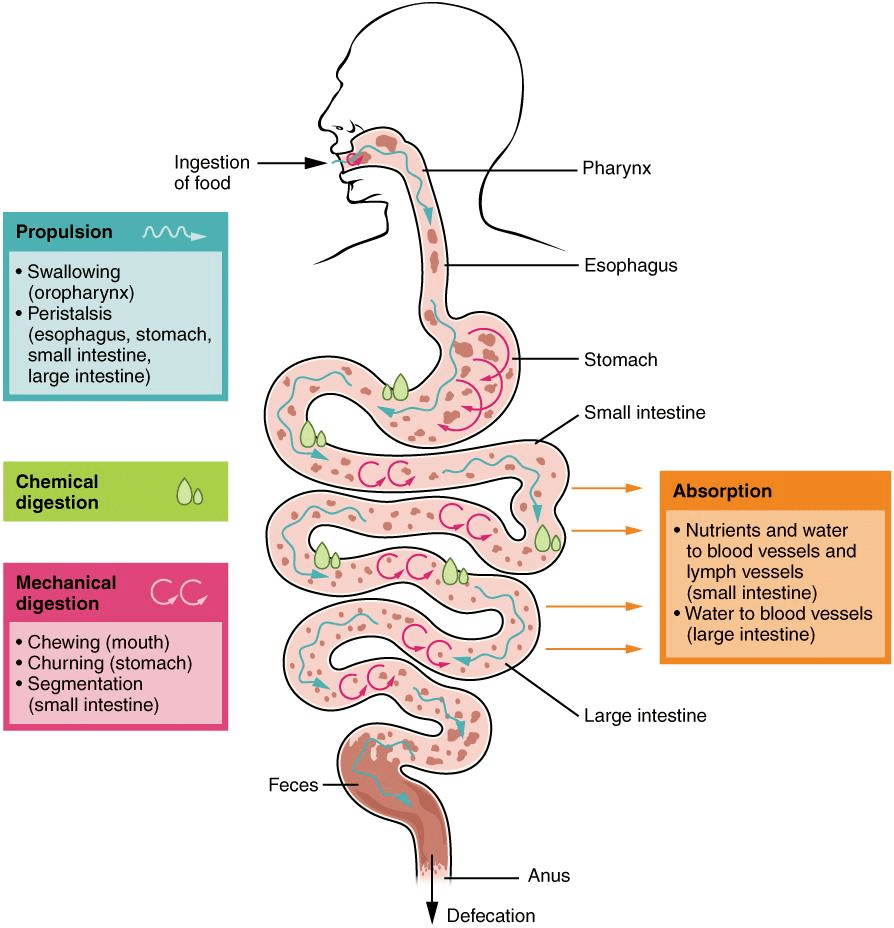 Physiology of Digestion
Physiology of Digestion
- Digestion is a form of catabolism or breaking down of substances that involves two separate processes: Mechanical Digestion and Chemical Digestion.
Digestion in the Oral Cavity
- Food enters through the mouth, food is tasted in the oral cavity and mixed with saliva, tongue mixes the food with saliva.
- This food with saliva is called the bolus. This saliva (pH 6.8 – 7.0) contains water (99.5%) and electrolytes (Na+, K+, Cl–, HCO3–, Thiocyanate).
In the mouth, teeth, tongue and lips have an important role in mechanical digestion through the process of chewing or mastication.
In this type of digestion, saliva act with food particles.
Saliva contain 99.5% water and 0.5% salts.
These salts are organic and inorganic type.
The main salts are mucin, lysozyme, thiocyanate and ptyalin.
(i) Mucin: It is a glycoprotein. It lubricates the food particles. It helps in the swallowing of food.
(ii) Lysozyme: It is an enzyme that kills harmful bacteria. Due to this reason saliva is an antiseptic lotion.
(iii) Thiocyanate: It is a special salt that kills harmful bacteria. So it is called bacteriocidal salt.
(iv) Ptyalin: Ptyalin is found in human saliva because human food is mainly made up of starch. Ptyalin digest only ripe and cooked starch. It does not digest the raw starch, 30% starch in the buccal cavity is digested by ptyalin. Ptyalin is absent in the saliva of rabbit and carnivorous animal because the food of rabbit is mainly made up of cellulose.
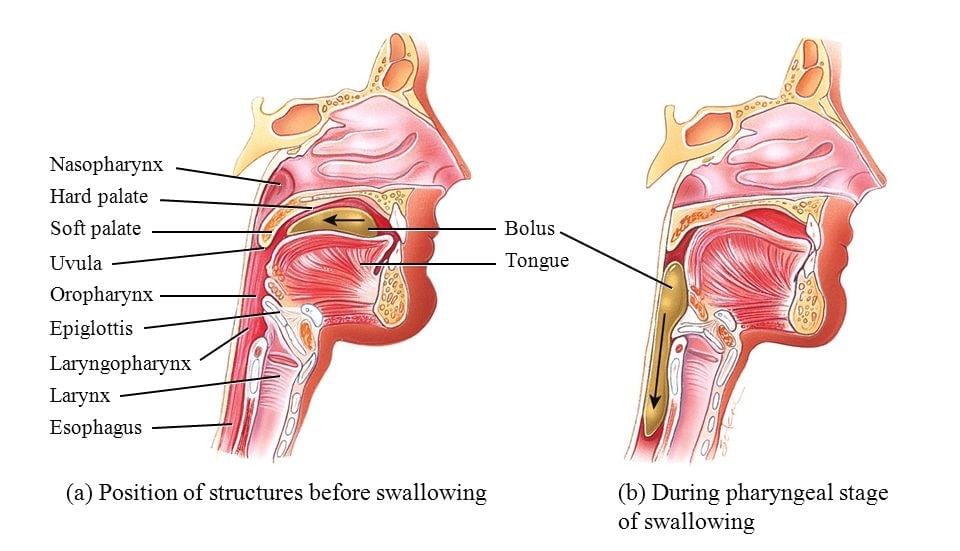
Bolus is pushed inward through the pharynx into the oesophagus this process is called swallowing or deglutition. It is a coordinated activity of the tongue, soft palate, pharynx and oesophagus.
The tongue blocks the mouth, part of the soft palate uvula close off the internal nasal opening nose and the larynx rises so that epiglottis closes off the trachea food move downward into the oesophagus A travelling wave of constrictions called peristalsis pushes the Bolus (food) downward.
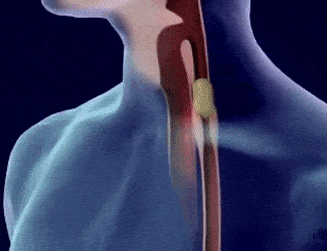 Peristalsis in Oesophagus
Peristalsis in OesophagusPeristalsis is the progression of the coordinated contraction of involuntary circular muscles, which is preceded by a simultaneous contraction of the longitudinal muscle and relaxation of the circular muscle in the lining of the gut.
 Esophageal Peristalsis
Esophageal Peristalsis
1: Food 2: Peristaltic wave
3: Oesophagus 4: Stomach
5: IntestineWhen a peristaltic wave reaches the end of the oesophagus, (Digestion or digestive enzymes are absent in Oesophagus) the cardiac sphincter/ Gastroesophageal sphincter opens allowing the passage of bolus food to the stomach.
The gastroesophageal sphincter normally remains closed and does not allow food contents of the stomach to move back.
Digestion of Food in Stomach
- When the food enters into stomach G-cells secrete gastrin hormones which stimulate the secretion of gastric juice by gastric glands.
- The secretion of gastric juice is controlled by nerve, hormones and chemical substances.
The secretion of gastric juice is divided into 3 phases: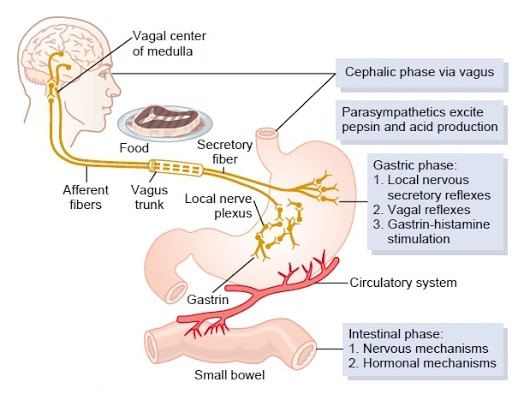 Gastric Juice Secretion Phases
Gastric Juice Secretion Phases
1. Cephalic Phase
- This phase is mediated by parasympathetic. It is the first step of secretion, stimulated by cranial nerves VII, IX & X.
- When a person sees the food then due to optic reflex small amount of gastric juice secretes in the stomach due to sight.
2. Gastric Phase
- When food enters the stomach the gastric phase is started. When food particles strike the fundic part of the stomach then a small amount of gastric juice is secreted due to strike reflex action and distention.
- Gastric juice develops the peristalsis movement in the stomach. Due to peristalsis food particles are rubbed on the mucosal layer of the stomach.
- Due to the rubbing process, cells stimulates and secretes the gastrin hormone. This hormone powerfully stimulates the gastric glands for the secretion of gastric juice.
Note:
Peristalsis in Oesophagus: Some drinking substances also stimulates the secretion of gastric juice such a soup, alcohol, caffeine, histamine. These drinking substances and gastric juice stimulate the desire for appetite. So these substances are called Appetiser juice.
3. Intestinal Phase
- When food reaches the Ileum, then the mucosal layer of the ileum secretes a chemical substance.
- Its nature is similar to histamine or gastrin. This chemical substance goes into the stomach through blood circulation where it stimulates the secretion of gastric juice.
- Its actual cause is yet unknown. But it is believed that this phase starts after 8-10 hour of taking of meal.
► Composition of Gastric Juice
- Water = 99.5%
- HCl = 0.2 - 0.3%
- pH = 1.5 to 2.5 (very acidic)
- Rest = mucus water, HCl and gastric enzymes (Pepsinogen, Prorennin, Gastric Lipase etc.).
► Functions of HCl
- The main function of HCl (activater) is to convert inactive enzymes (zymogens) into active enzymes.

- It destroys all the bacteria present in the food.
- HCl stops the action of saliva on food. In the stomach, the medium is highly acidic.
- It dissolves the hard portions of the food and makes it soft.
- Pepsinogen and Prorennin are inactive enzymes.
► Digestion by Rennin (Chymosin)
- Rennin is active in the childhood stage of mammals only. It converts milk into a curd-like substance (clot the milk) and then digests it. In the adult stages, it is inactive.
- Rennin, acts on milk protein casein. Casein is a soluble protein.
- In presence of Rennin, casein gets converted into insoluble Ca-paracaseinate. This process is termed as the curdling of milk. After becoming insoluble, milk can remain in the stomach for a longer time. Rennin is absent in human (clotting/ coagulation/ curdling of milk is done by HCl, pepsin and chymotrypsin in human).
► Digestion by Pepsin
- Inactive pepsinogen on getting proper pH converts into active pepsin.
- Peptidase: The enzyme which breaks the peptide bond.
These peptidases are of two types:
(i) Exopeptidase: The peptidase enzyme that breaks the outer and marginal bond of a polypeptide called exopeptidase. In this process, amino acid and polypeptides are formed.
(ii) Endopeptidase: The peptidase enzyme that breaks the inner peptide bond of large polypeptide and forms the small polypeptides such as peptone, proteoses and peptides. Pepsin is the strongest Endopeptidase. It breaks proteins into smaller molecules. In the stomach, endopeptidases are found so only digestion of proteins can take place properly in the stomach.
In the stomach, endopeptidases are found so only digestion of proteins can take place properly in the stomach.
► Digestion by Gastric Lipase
It converts fats into fatty acids and glycerols. It is secreted in a less amount so less digestion of fats takes place here.
This lipase acts on emulsified fat and converts it into fatty acid & glycerol. 1% of emulsified fat is present in the food.
Peristalsis continues during the process of digestion so the gastric -juice mixes properly with the food. Due to peristalsis, the food is converted into a paste. This form of food which is thick, acidic & semi-digested in the stomach is called chyme.
After short intervals, the pyloric valves keeps on opening and closing so the chyme is fed into the intestine in installments.
Digestion Of Food In Small Intestine
In the small intestine, mechanical and chemical digestion occurs.
► Mechanical Digestion
This process of digestion mainly occurs with the help of segmentation. It is a mixing of a kind with digestive juice and brings food particle into contact with the mucosa.
It starts with the contraction of circular muscle this action constrict the intestine in the small segment and further each segment constrict from the middle and divide each constricted segment again.
Finally first contracted fibre relax and each small segment unite with adjoining small segment, so large segment form again.
Chemical Digestion
➢ Digestion of Food in Duodenum
- When food leaves the stomach through its pyloric end and enters the duodenum it is called chyme (acidic).
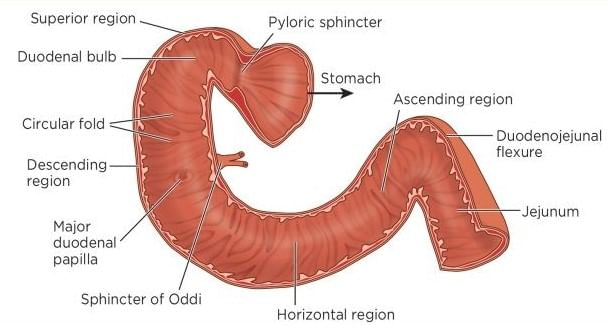 Internal Structure of Duodenum
Internal Structure of Duodenum - The HCl of chyme stimulates different enteroendocrine cells which are found in the intestinal gland or crypts of liberkuhn, in these specific modified cells are called K-cells which secrete glucose-dependent insulinotropic peptide or GIP, this hormone stimulates the secretion of insulin.
- Including this, the following hormones also secrete through the duodenum:
(i) Secretin: It is the most important hormone of the digestive tract and also the first discovered hormone. This hormone stimulates the pancreas for synthesis and secretion of the non-enzymatic part of pancreatic juice. It also stimulates the liver for secretion of bile juice and inhibit the gastric juice secretion in the stomach and reduce the rate of contraction of the stomach.
(ii) Pancreozymin: It stimulates the synthesis as well as secretion of pancreatic-juices. Secretin promotes the secretion of the non-enzymatic part of the pancreatic juice, while pancreozymin promotes the secretion of the enzymatic part of the pancreatic juice.
(iii) Hepatocrinin: It promotes the synthesis and secretion of bile juice in the liver.
(iv) Cholecystokinin: It stimulates the liver and the gallbladder (mainly gallbladder) to secrete Bile-juice.
(v) Duocrinin: It stimulates the Brunner's gland for synthesis and secretion of the non-enzymatic part of intestinal juice.
(vi) Enterocrinin: This hormone stimulates Paneth cells for synthesis and secretion of enzymatic part of intestinal juice.
(vii) Villikinin: It stimulates the activity of villi.
(viii) Enterogasterone: It inhibits the secretion of HCl in the stomach.
(ix) Gastric Inhibitory Peptide (GIP): In inhibits the secretion of gastrin hormone.
(x) Vasoactive intestinal peptide and somatostatin: They inhibits the motility of the stomach.
➢ Bile Juice
- In the proximal part of the duodenum, bile-juice is secreted. The parenchyma cells of the liver produce bile-juice and it is stored in the gallbladder.Different Types of Digestive Juice
- Bile-juice does not contain any digestive enzyme. Therefore it is not a true digestive juice (Pseudodigestive juice).
► Composition of Bile Juice
- Bile-juice is a greenish (Biliverdin) yellow (Bilirubin) coloured alkaline fluid.
► Composition of Liver Bile
- Liver bile pH is 8.0.
- H2O: 98%
- Organic constituents are bile acid, bile pigment, cholesterol, Lecithin, inorganic constituents Na+, K+ etc.
- Bile pigments are the excretory substances of the liver.
► Types of Bile Salts
Bile salts are of two types:
(a) Inorganic Salts: Bile juice contains NaCl, Na2CO3, NaHCO3 etc. in it. Inorganic salts neutralize the acidity of the food and make the medium basic. It is necessary for the medium to become basic because the pancreatic-juices enzymes can act only in the basic-medium.
(b) Organic Salts: Organic salts like Na-glycocholate and Na-taurocholate are found in Bile juice. The main function of these salts is the emulsification of fats. Because pancreatic lipase can act only on emulsified fats.
Bile salts also help in the absorption of fats and fat-soluble vitamins (A, D, E, K). Bile salts combine with fats, cholesterol, phospholipid (lecithin) and these vitamins to form compounds called Micelles which are absorbed rapidly. In the form of micelles, cholesterol and phospholipid (lecithin) remain soluble.
► Functions of Bile Juice
Neutralization of HCl: Its sodium neutralizes HCl of chyme (semifluid food found in the stomach).
Emulsification: Sodium glycocholate and sodium taurocholate are bile salts that break the large fat droplets into smaller ones.
Absorption of Fat and Fat-soluble Vitamins: Its salts help in the absorption of fat (fatty acids and glycerol) and fat-soluble vitamins (A, D, E and K).
Excretion: Bile pigments (bilirubin and biliverdin) are excretory products.
Prevention of Decomposition: Bile is alkaline hence it prevents the decomposition of food preventing the growth of bacteria on it.
Stimulation of Peristalsis: Bile increases the peristalsis of the intestine.
Activation of Lipase: Bile contains no enzyme but activates the enzyme lipase.
Bile-pigments, cholesterol and Lecithin are the excretory substances found in Bile juice.
Gall Stone: Sometimes the passage inside the bile-duct gets blocked or becomes narrow, so the cholesterol gets deposited or precipitated in the gall-bladder. This is termed as the Gall-stone (cholelithiasis).
Obstructive Jaundice: If the passage of bile is blocked then the amount of bilirubin increases in the blood. So the yellowish colouration of the body like skin, cornea and nails appear yellow. Urine also becomes yellow.
➢
Pancreatic Juice
- Pancreozymin stimulates the acini and glandular cells so pancreatic juice is secreted.
The pancreatic juice is secreted by the exocrine cells of the pancreas.
Pancreatic juice is a highly odoriferous, colourless basic fluid which contains enzymes and salts.
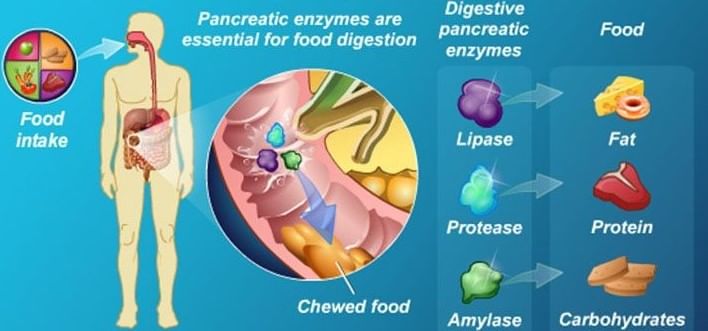 Role of Pancreatic Enzymes
Role of Pancreatic Enzymes
► Composition of Pancreatic Juice
- Total amount in man = 500-800 ml/day
- Water = 98%
- pH = 7.5-8.3
- Salts = 2%
- Pancreatic juice contains only inorganic salts.
The action of enzymes present in the pancreatic juice is as follows:
- Pancreatic α - Amylase: Amylase and Amylopsin dissociates starch into Maltose. The majority of starch breaks up into the duodenum.
- Trypsinogen and Chymotrypsinogen: The step by step action of these enzymes is as follows:

- Enterokinase is secreted by the Duodenal mucosa.
- Trypsin and chymotrypsin are Endopeptidase type of enzymes. They dissociate proteins into peptones and proteoses. The majority of proteins are broken into the stomach and the remaining are broken into the duodenum.

- Procarboxy Peptidase: These are also called zymogens. Trypsin converts it into active Carboxy-peptidase.

- Fat Digesting Enzyme: In pancreatic juices, various Fat-digesting enzymes are found which are collectively called steapsin.
- Pancreatic Lipase: It converts triglyceride into monoglyceride, fatty acid, glycerol.
- Cholesterol Esterase: It digests cholesterol esters. These esters are made up of cholesterol and fatty-acids like Lanolin, cholesterol and Palmitic acid.
- Phospholipase: These digest phospholipids.
- DNase and RNase: Digestion of DNA and RNA.
➢
Digestion in Jejunum and Ileum
- These hormones stimulate the crypts of Leiberkuhn to secrete Succus-entericus or intestinal juice. This succus entericus mainly contains water (99%) and digestive enzymes (<1%). Intestinal juice act on the food.
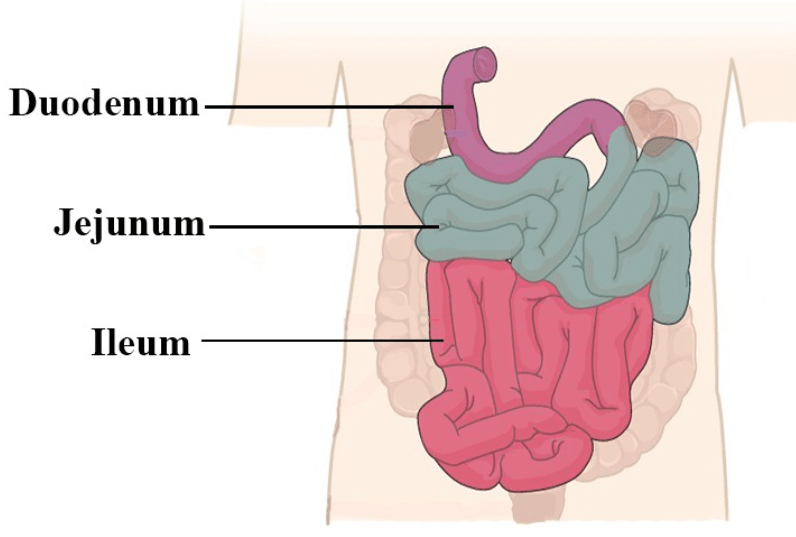 Different Parts of Small Intestine
Different Parts of Small Intestine - Succus-entericus mainly contains the following enzymes Peptidase or Erepsin. This is a type of Exopeptidase. It converts oligopeptides into amino-acids.
- Disaccharidases Sucrase: It is also known as Invertase. It converts sucrose into glucose and fructose.
- Maltase: It converts maltose sugar into glucose molecules.
- Lactase: This enzyme is found only in mammals. It converts milk sugar Lactose into glucose and galactose.
- Intestinal Lipase: This fat-digesting enzyme converts fats into fatty acids and glycerol.
- Nucleotidase and Nucleosidase: These act in the following way:


- Maximum digestion of carbohydrates is done in the duodenum, but its digestion is completed in Jejunum.
An Overview of the Action of Major Enzymes in Human
Enzyme | Site of Action | Substrate | Products of Action | |
Salivary Juice (Salivary Gland) | ||||
Salivary amylase or Ptyalin | Mouth and Stomach | Starch | Disaccharides (few) | |
|
| Buccal cavity |
|
|
Gastric Juice (Stomach) | ||||
a) | Pepsinogen: pepsin | Stomach | Proteins | large peptides |
Pancreatic Juice (Pancreas) | ||||
a) | Pancreatic a-amylase ( Duodenum) | Small, intestine | Starch | Disaccharides |
b) | Trypsinogen: trypsin | Small, intestine | Proteins | large peptides |
| Chymotrypsin | Small, intestine | Proteins | large peptides |
d) | Elastase | Small, intestine | Elastin | Oligopeptides |
e) | Carboxypeptidases | Small, intestine | large peptides | Amino-acid |
f) | Aminopeptidase | Small, intestine | large peptides | Oligopeptides |
g) | lipase | Small, intestine | Triglycerides, fatty acids, glycerol | Monoglycerides |
h) | Nucleases | Small, intestine | Nucleic acids | Nucleotides |
Intestinal Juice (Small Intestine) | ||||
a | Enteropeptidase or enterokinase | Duodenum | Trypsinogen | Trypsin |
b | Peptidase | Duodenum | Oligopeptides | Amino acids |
c | Disaecharidases | Duodenum | Disaccharides | Monosaccharides |
d | Nucleotidase | Duodenum | Nucleotides phosphoric: acid | Nucleosidases |
e) | Nucleosidases | Duodenum | Nucleosides pyrimidines | Sugars, purines |
Role of some major Gastrointestinal Peptide Hormones in Digestion:
- Hormone: Gastrin
Source Secretion: Pyloric stomach and duodenum / G-cells.
Stimulus to: Vagus nerve activity; peptides and proteins in the stomach.
Target / Action: Secretory cells and muscles of the stomach; secretion of HCl and stimulation of gastric motility. - Hormone: Cholecystokinin (CCK)
Source Secretion: Upper small intestine (Duodenum)
Stimulus to: Food (fatty chyme and amino acids) in the duodenum.
Target / Action: Gall bladder; contraction of gall bladder (bile release). - Hormone: Secretin
Source Secretion: Inttiralvall (Duodenum)
Stimulus to: Food and strong acid in stomach and intestine.
Target / Action: Pancreas, secretory cells and muscles of the stomach; secretion of water and bicarbonate(NaHCO3); inhibition of gastric motility. - Hormone: Gastric Inhibitory Peptide (GIP)
Source Secretion: Upper small intestine (Duodenum)
Stimulus to: Monosaccharides and fats (fatty chyme) in the duodenum.
Target / Action: Gastric mucosa and muscles; inhibition of gastric secretion and mobility/motility (slowing food passage).
➢
Digestion in Caecum
➢
In herbivores, the symbiotic bacteria and protozoans present in the caecum help in the digestion of cellulose into glucose. So the digestion of cellulose takes place in the caecum by the process of decomposition.
This decomposition process is very slow. So very less amount of cellulose is digested at a time in the caecum.
In the last part of the large intestine, faeces is temporarily stored.
Note:
- Maximum digestion of food – Duodenum
- While digestion of food completes in – Jejunum
- Maximum absorption of food in – Jejunum
The Small Intestine
Ironically, the longest part of the alimentary canal is the small intestine. It is a highly coiled structure of about 7.5 meters in length. It is a very narrow tube with a large internal surface area. It is the site of complete digestion in humans. It absorbs digested food completely. It secretes intestinal juice. It receives bile juice from the liver and pancreatic juice from the pancreas.
The small intestine is divided into three parts:
(i) Duodenum
(ii) Jejunum
(iii) Ileum
 The Small Intestine
The Small Intestine
Functions of Small Intestine
1. Complete Digestion of Food
- The partially digested food is absorbed by the duodenum of the small intestine along with the digestive juices from the liver, pancreas and its own walls.
- The liver secretes the bile juice, which converts fat into tiny droplets so that their digestion becomes easy.
- The pancreas produces pancreatic juice that breaks down fats into fatty acids and glycerol.
- The intestinal juice secreted by the walls of the small intestine breaks down starch and carbohydrates into simple sugars. These sugars are known as glucose. It also converts the proteins into amino acids.
- All these simple, broken down forms are called the digested food.
2. Absorption of Digested Food
- The food that is digested is absorbed into the blood vessels in the walls of the intestine.
- The finger-like projections known as villi, drastically increase the surface area of the small intestine for greater absorption of the digested food.
- The blood carries the absorbed food material to different parts of the body. Glucose breaks down to form oxygen and carbon dioxide and releases the energy required for various life processes.
- The undigested and unabsorbed food passes from the small intestine to the large intestine.
|
221 videos|172 docs|126 tests
|
FAQs on Digestion of Food - Biology for JAMB
| 1. What is the physiological process of digestion? |  |
| 2. What is chemical digestion? |  |
| 3. How does the small intestine contribute to digestion? |  |
| 4. What are the functions of the small intestine? |  |
| 5. How does the small intestine digest food? |  |
















